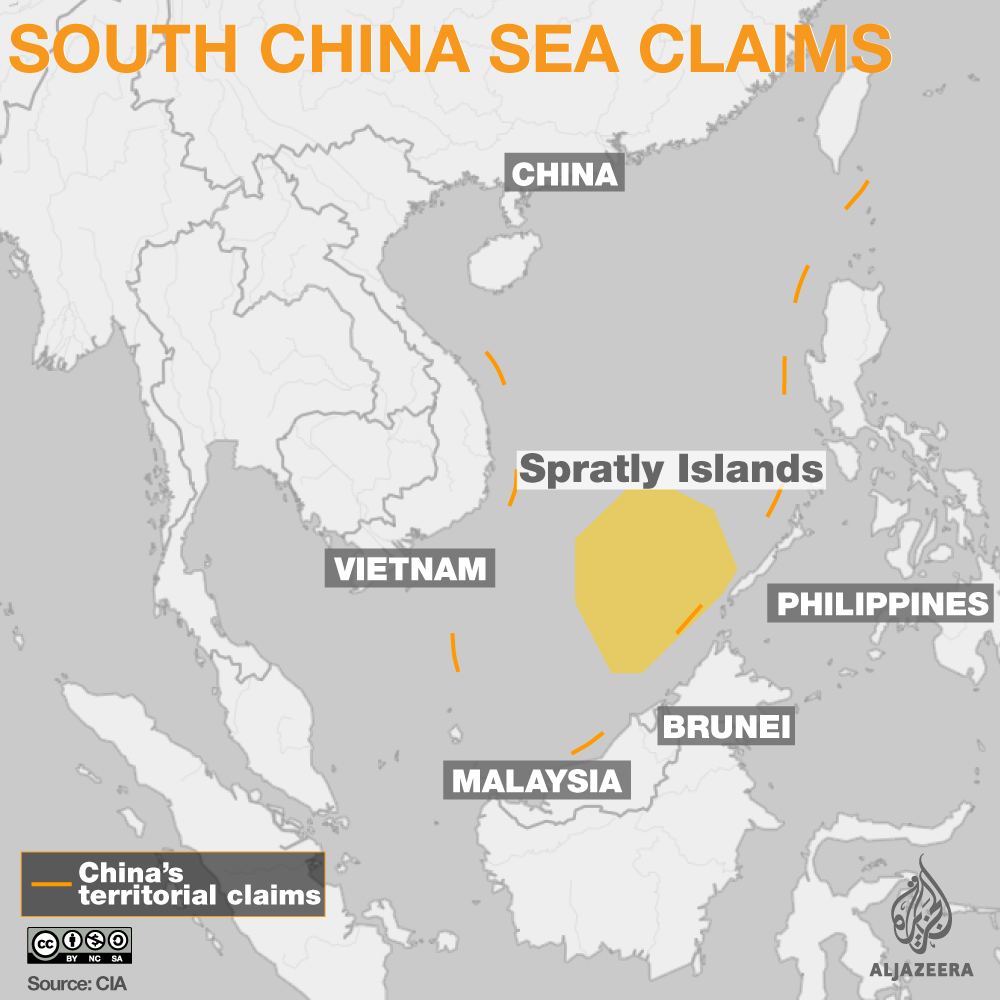Beijing’s South China Sea claims scrutinised at summit
Southeast Asian leaders meet amid tension over Beijing’s increasingly assertive claims to territory in South China Sea.

The Philippines and Japan have both expressed serious concern over China’s actions in the South China Sea at a regional meeting of Asian leaders in Laos.
Hours before leaders of the 10-member Association of Southeast Asian Nations (ASEAN) met China’s Premier Li Keqiang at the summit in Vientiane on Wednesday, the Philippines released photos purportedly showing Chinese vessels near a disputed chain of reefs and rocks in the South China Sea.
Keep reading
list of 4 itemsPhilippines summons China envoy over water cannon attack in South China Sea
China coastguard blasts water cannon at Philippine coastguard ship
Philippines and China in new confrontation at Scarborough Shoal
The Philippines said the images showed Chinese ships near Scarborough Shoal and that the vessels were capable of dredging sand and other activities required to build artificial islands.
“We have reason to believe that their presence is a precursor to building activities on the shoal,” Arsenio Andolong, the Philippines defence department spokesman, told AFP news agency.
“We are continuing our surveillance and monitoring of their presence and activities, which are disturbing,” he said.
“We are gravely concerned.”
Japan’s Prime Minister, Shinzo Abe, also expressed concern about China’s increasing muscular claims to dispute maritime territory in the South China Sea on Wednesday.
“I am seriously concerned with the continuing attempts to change unilaterally the status quo in the East and South China Sea,” Abe said in a statement released at the Asean summit.
Abe called for a “peaceful settlement of the dispute” between the Philippines and China over their competing claims in the sea.
China, Taiwan, the Philippines, Vietnam, Malaysia and Brunei claim parts or all of the resource-rich South China Sea, making it a hot spot of regional tension.
Japan’s dispute with China is over uninhabited islands in the East China sea, known as the Senkakus in Tokyo and as the Diaoyus in Beijing.
|
|
China claims nearly all of the South China Sea, through which $5 trillion in shipping trade passes each year.
A UN-backed tribunal ruled in favour of the Philippines in July, declaring that China’s claims to almost all of the sea had no legal basis and its construction of artificial islands in disputed waters was illegal.
China pledged to ignore The Hague ruling, calling it “null and void”.
Officials said the talks on Wednesday between the Asean leaders and China’s Li went smoothly, despite the release of the photos by the Philippines just before the meeting.
Hua Chunying, spokeswoman for the Chinese foreign ministry, also told a daily briefing in Beijing that there had been no change in the situation around the Scarborough Shoal and that China had not taken any new action there.
“Given this situation, some people are hyping the situation by spreading that kind of information,” she said, according to Reuters news agency.
Al Jazeera’s Step Vaessen, reporting from Vientiane, said the Chinese denied anything unusual was occurring at the shoal, and harsh words were avoided when the Philippine President Rodrigo Duterte addressed the Chinese premier in the Asean meeting.
“The Chinese Foreign Ministry immediately said that these allegations were baseless and that nothing
has changed in the area, and that people who make these allegations, their intentions should be questioned,” Vaessen said.
|
|
Duterte told the ASEAN meeting that the international dispute should be solved “within the boundaries of the law”, our correspondent added.
“Basically, he was avoiding mentioning July’s arbitration ruling about the South China Sea which was in favour of the Philippines.”
Artificial islands
Competing territorial claims in the South China Sea have long been a source of tension in the region, with China, historically, using deadly force twice to seize control of islands from Vietnam.
Concerns have intensified sharply in recent years as China has built artificial islands on reefs and islets in the Spratlys archipelago – another strategically important location – that are capable of supporting military installation and operations.
An artificial island at Scarborough Shoal would potentially give China a military base near where US forces regularly operate on the Philippine main island of Luzon, which is only 230km away.
US President Barack Obama is also in Laos for the regional meetings, which will conclude on Thursday with an East Asia summit.
